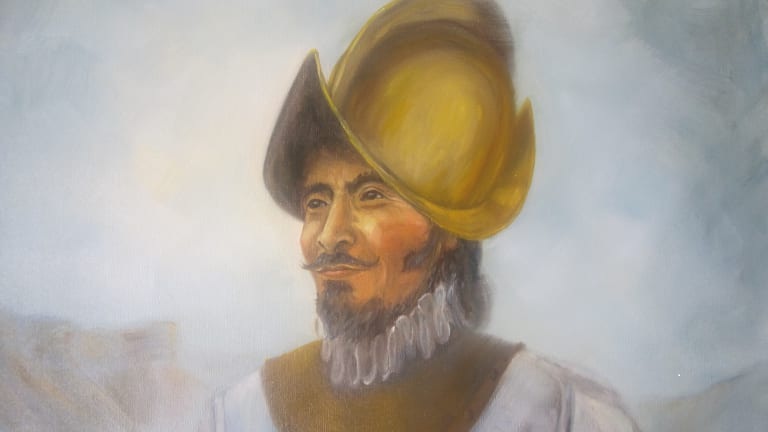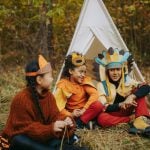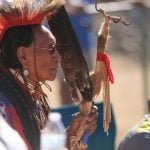Hopi Migrations

In 1540 Francisco Vásquez de Coronado began his journey north from Mexico seeking the legendary Seven Cities of Cibola. He had with him a force of 330 Spaniards (most of whom were mounted soldiers) and 1,000 native allies. After conquering Zuñi Pueblo, Coronado sent an expedition under the command of Captain Pedro de Tovar to make contact with the Hopi. The Hopi met the Spaniards at the town of Kawaika-a with coldness. The Hopi were in battle formation and drew a line on the ground with sacred corn pollen telling the Spaniards not to cross it. There was a short battle that was won by the Spaniards. At this time there were an estimated 29,000 Hopi who lived in several well-established villages, many of which were defensively located on mesa tops.
The designation Hopi comes from a contraction of Hopi-tuh which means “peaceful ones.” While outsiders have often insisted on discussing the Hopi as a tribe, they are a collection of independent, autonomous villages (Pueblos) which are unified by a common language and common cultural traditions. While the Hopi had lived in their villages for several centuries prior to their first encounter with the Spanish (the Hopi village of Oraibi had been established by 1100 CE), their oral histories and the archaeological record tell of many migrations. Some of these oral traditions speak of a migration from the Old World to the New World, a migration made across water rather than across lands.
One of the most important features of Hopi social organization is their clans: matrilineal, named, exogamous, family units. Matrilineal clans mean that each member of Hopi society belongs to a single clan and that clan membership is the mother’s clan. Being exogamous means that clan members may not marry people from the same clan.
The Hopi migration stories are histories of the Hopi clans. According to Hopi traditions, the clans migrated independently, arriving in the Hopi homelands at different times and from different directions. The clan name often reflects an episode in the clan’s migrations. Each clan has its own stories about its migrations across the Southwest and their arrival at their present villages.
There was often a pattern of settling down, building villages and preparing new fields for their corn and other plants. Then would come another migration. When an area was abandoned, the remains of the Hopi ancestors were left behind. These ancestors are important as the weather patterns-something very important to dry land farmers-are controlled by spirit ancestors.
Before they began their wanderings, the deity Maasaw gave the Hopi tablets which sealed their covenant with him.
Upon their emergence from the Underworld at the Sipapu, the Hopi began their search for the homeland promised them by Mockingbird. Each group that left the Sipapu (the sacred entrance to the underworld) was accompanied by an old woman. It was the wisdom of this elder that would be counted on during the long time of wandering. For this reason, Hopi women have always played an important part in village secular and religious life.
The Hopi promised land was to be an area where they would find security from enemies who waged war against them, soil suited to their plants (corn, beans, cotton), an adequate supply of game and, most important, a dependable supply of water. All of these are found in the mesas of northern Arizona where they established their villages.
At first the Hopi all traveled to the east. One group, led by Bahana, went so far east that he could touch his forehead to the Sun. Here they settled and planted their crops. The other Hopi groups spread out in many directions, often pausing for several seasons at certain places. Then they would continue their search for the promised land.
One of the wandering bands of Hopi under the leadership of Matcito found the body of a dead bear near the Little Colorado River. Considering this to be a significant omen, this group became the Bear Clan. Later, a second band of Hopi came upon the bear’s carcass. Since they needed help in carrying their possessions, they cut long straps from the bear’s hide and are thus known as the Strap Clan. Several days later, a third party of Hopi came upon the dead bear, which was now just a skeleton. They found several bluebirds perched on the bones and took this as a sign to name themselves the Bluebird Clan. The fourth group to come upon the bear found a spider with a large web in the center of the skeleton and took the name Spider Clan. The fifth group to find the bear’s skeleton noted that there were now many holes made by moles and became the Mole Clan. Many months later, a sixth Hopi group came upon what remained of the bear. When they examined the skull they found a strange substance in the eye cavities and so they became the Greasy Eye Cavities Clan.
The Bear Clan camped at Kuiwanva and it was here that the god Masau-u, the death god and the patron of all food plants, visited them. The Bear Clan people asked Masau-u if he would give them some of his land and allow them to build their village there. Masau-u then showed them where they could build their village, and today this is the site of Oraibi (also spelled Orayvi). As other clans would later approach the village, they would have to ask the village chief, a member of the Bear Clan, for permission to settle in the village. The Bear Clan chief would always ask them what they could contribute to the village before allowing them to settle there.
The Hopi Snake Clan once settled at Tokoonavi, which is northeast of the Grand Canyon near Navajo Mountain. Tiyo, the son of the village chief, made a boat and journeyed down the Colorado River to the ocean and from there to a small island. After adventures with the snake people (the reason for the Clan’s name), Tiyo returned home. Tiyo and his wife eventually decided to seek a new home and came to Walpi where they asked to be allowed to live.
Like the Snake Clan, the Horn Clan traces its roots to Tokoonavi. After they left this village to search for a site for a permanent home, they came to Lenyanobi which was inhabited by the Flute Clan. The people of the Flute Clan made the Horn Clan welcome and after a while the two people became very closely related. After living at Lenyanobi for a long time, the two clans continued the search for their homeland. Near the Hopi village of Walpi, they built the village of Kwactapahu. When they discovered that the Snake Clan people, which whom they had lived at Tokoonavi, were now living at Walpi, they were made welcome and entered the pueblo.
The Hopi Water clans-Young Corn, Cloud, Tadpole and Frog, Snow, and Rabbitbrush-have an oral history in which they migrated to Hopi country from Palotquopi, a region of red rocks. This area probably lies near the pueblo of Casas Grandes in Chihuahua, Mexico. As they migrated north, they lived for a while at the Zuñi pueblo of Hawikuh. Eventually, the Snake Clan chief welcomed the Water Clans to Walpi.
The Hopi Katsini and Parrot Clans also have a tradition which tells of a migration from the south, possibly Casas Grandes. As with the Water Clans, there is also some indication that these two clans lived for a while with the Zuni.
The Firewood or Kokop Clans-Coyta, Masau-u, Yucca, Pinyon-have an oral tradition that says they came to the Hopi from villages on the Jemez Plateau in New Mexico. Several other clans-Sun, Moon, Stars, Sun’s Forehead, Eagle, Hawk, Turkey-also have traditions about living in the pueblos of New Mexico.
The Badger Clan wandered for a long time after emerging from the Underworld. They then settled a Kisiu-va in the San Francisco peaks. Here they lived for a time with members of the Katsina Clan. Early in their wanderings, the Badger Clan had established the village of Tuwanacabi, north of the present-day Hopi villages. They then moved to the Oraibi Wash where they built the village of Siu-va. It was at this time that they became interested in the badger and became the Badger Clan. Later they moved to the village of Oraibi.



